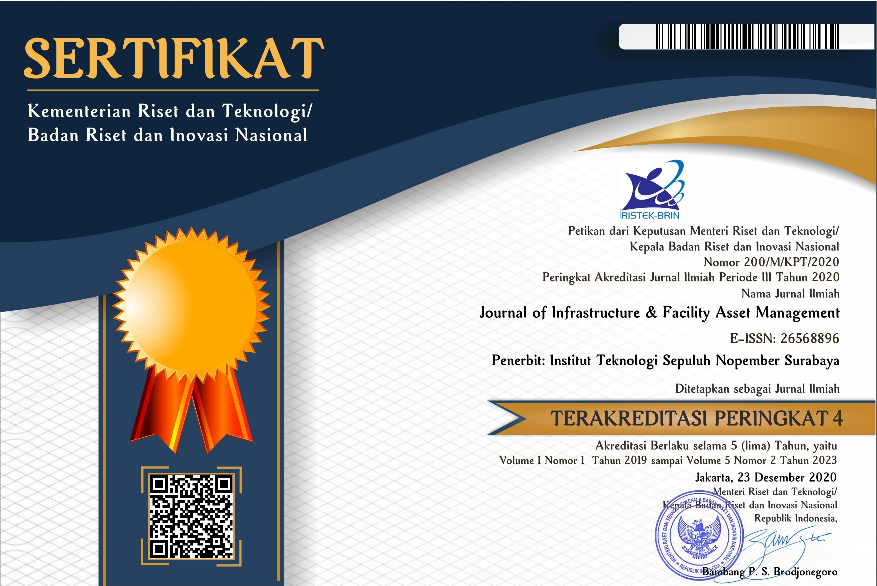Geotechnical Mapping for Soil Physical and Mechanical Parameters and Hard Soil Depth in Badung Regency
Abstract
Full Text:
PDFReferences
Ali, Fauziah dkk. (2018). “Kajian Geoteknik untuk Perencanaan Pembangunan Pemukiman Baru pada Kawasan Handil Berkat Makmur, Kabupaten Kapuas, Kalimantan Tengah”. Jurnal Geosains dan Teknologi, Vol.1, No.2, Hal 50 - 58.
Bowles, J.E., (1984). Sifat-Sifat Fisis Dan Geoteknis Tanah. Erlangga, Jakarta.
Das, Braja M., (translated by Mochtar N.E, and Mochtar I.B.). (1985). Mekanika Tanah Prinsip-Prinsip Rekayasa Geoteknik. Jilid I. Erlangga. Jakarta.
Das, Braja M., (translated by Mochtar N.E, and Mochtar I.B.). (1985). Mekanika Tanah Prinsip-Prinsip Rekayasa Geoteknik. Jilid II. Erlangga. Jakarta.
Hakam, Abdul. (2008). Rekayasa Pondasi. CV. Bintang Grafika. Padang.
Hasbi, Yudi. 2021. Analisis Potensi Likuifaksi Berdasarkan Data SPT dan CPT. Universitas Islam Indonesia. Yogyakarta.
Kosasih.,A., Mochtar.,I.B., (1997). ‘Pengaruh Kadar Air, Angka Pori, dan Batas Cair Tanah Lempung Terhadap Indeks Pemampatan Konsolidasi Cc dan Indeks, Pengembangan Cs”. Master Thesis., Program Pasca Sarjana. Teknik Sipil ITS. Surabaya.
Lee, Ian Kenneth, dkk. (1983). Geotechnical Engineering. University of New South Wales, Australia.
Mochtar, Indrasurya B. (2006). “Empirical Parameters for Soft Soil in Situ”. Revised (2012). Civil Engineering Dept. Institut Teknologi Sepuluh Nopember (ITS), Surabaya.
Mochtar, Indrasurya B. (2012). “Kenyataan Lapangan sebagai dasar untuk usulan konsep baru tentang analisa kuat geser tanah dan kestabilan lereng”. 16th Annual Scientific Meeting 2012.
Satrya, Trihanyndio Rendy, Ria Asih Aryani Soemitro, dkk. (2014). “Engineering Geological Mapping at Center of Surabaya Region by Developing Geo-Tomography Image Analysis”. Celebes International Conference on Earth Science (CICES).
Tazakka, Merdeka Sandi. (2021). Modul Rockworks™. Untuk Teknik Sipil (Geoteknik).
Tim Penyusun Esa Unggul. (2018). Modul Pembelajaran ArcGIS. Universitas Esa Unggul.
Suprayitno, Hitapriya, et al. (2020). “Preliminary Reflection on Performance Indicator and Performance Factor for Infrastructure Asset Management”. Journal of Infrastructure & Facility Asset Management - JIFAM. 2(1) March 2020.
Suprayitno, Hitapriya, et al. (2020). “Preliminary Reflection on Basic Principle of Operation Management for Public Work Infrastructure Asset Management”. Journal of Infrastructure and Facility Asset Management - JIFAM 2(Sup1) December 2020.
Suprayitno, H. & Soemitro, R.A.A (2018). ”Preliminary Reflexion on Basic Principle Infrastructure Asset Management”. Jurnal Manajemen Aset Infrastructur & Facilitas – JMAIF 2(1) Maret 2018.
DOI: http://dx.doi.org/10.12962%2Fjifam.v4i2.14371
Refbacks
- There are currently no refbacks.
Visitor :
Flag Counter

Journal Of Infrastructure & Facility Asset Management by Institut Teknologi Sepuluh Nopember is licensed under a Creative Commons Attribution-ShareAlike 4.0 International License.





